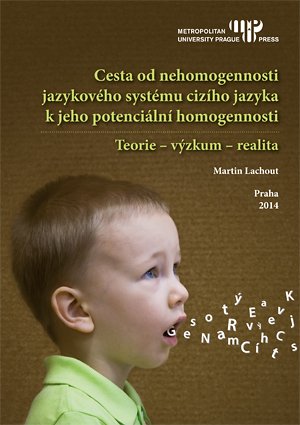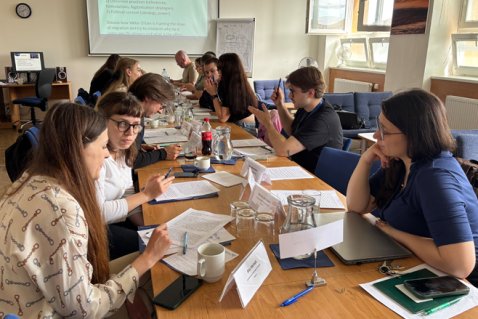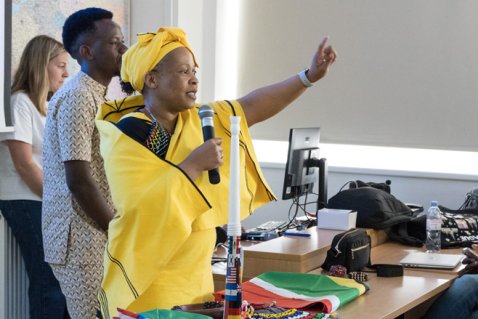LACHOUT, Martin. Cesta od nehomogennosti jazykového systému cizího jazyka k jeho potenciální homogennosti.

1st ed. Prague: Metropolitan University Prague Press, 2014. ISBN 978-80-87956-03-8
The submitted work deals with problems concerning the application of compensation strategies in the process of overcoming language barriers faced by Czech native speakers in the German language, as one amongst various psycholinguistic models pertaining to speech production.
The work is divided into two parts. The first, theoretical, part focuses on compensatory skills in a foreign language as such. Their treatment is restricted to the lexical aspect of mastering a foreign tongue. The section functions as a theoretical basis for the second, empirical, part of the book, which concentrates on compensatory skills used by Czech-speaking students in the German language. The research was carried out in Prague and out-of-Prague grammar schools on the sample of 176 respondents.
This forms the point of departure for the second theoretical section dealing exclusively with Czech speakers' utterances in a foreign language.
The book’s empirical section is subdivided into several subsections. One analyses German textbooks used by the grammar schools where our empirical research was conducted. The analysis is concerned with the presence of exercises developing compensative skills in the textbooks in question, with their individual presentation and consolidation.
Combined qualitative and quantitative textbook analysis has shown that such skills are being developed to various degrees, depending on both the frequency of their presence and on their typology level. The textbooks tested contain both partial and comprehensive exercises. The most frequent type of partial exercise is a periphrastic one. In the periphrastic type of exercise students either describe given expressions and phrases or transform complete utterances (this often concerns transforming complex grammatical phenomena). A less frequent type of exercise is a substitutive one, where students work with synonymic expressions and substitute words or word phrases. The author has analytically established that the textbooks concerned pay almost no attention to another compensation technique, the technique of reduction. This type of exercise was registered merely in one textbook, namely, Themen neu 2. In parallel to the absence of exercises fostering reduction skills (with the exception of Zwischen den Pausen textbook), exercises aimed at non-verbal communicative practice are likewise excluded. The most frequent exercises in the textbooks tested are comprehensive exercises. These are found both in translational and non-translational form. These exercises vary. Students are initially requested to describe, in their own words, separate pictures or pictorial sequences with a general meaning; subsequently, they may be called on to explicate and comment on graphs, to adequately react in various artificially created situations, to express their opinions on given problems etc. up to relatively complex exercises which ask for a presentation or a speech on an assigned topic. The above-mentioned types of exercises are exemplified in partial analyses of individual textbooks.
The analysis has also yielded the finding that there is no mutual connection among the exercises teaching speakers to use compensation strategies in situations of linguistic inadequacy, the exercises appear random, without gradation in complexity.
The next important subsection of the third empirical part, which is also the crucial part of the book itself, includes an analysis of research results collected by the author himself, in the form of a questionnaire addressed to selected Prague and out-of-Prague grammar schools. 176 final-grade students of public and private grammar schools in the Districts of Prague and Central Bohemia took part in the research. The questionnaire as a whole was prepared by the author himself.
The questionnaire presented here is directly geared exclusively towards the ability to use compensative utterances in the communication process in a foreign tongue. The author limited his research solely to the lexical level. The questionnaire consisted from 5 exercises. All these exercises were created by the author himself.
Four exercises are intended as partial ones aimed at mastering compensation issues, in which the author observed partial skills in the students questioned (exercise no. 2 was, in contrast to the remaining ones, set in context; selected verbal units and phrases are loaded). The last, fifth exercise is a text taken from the daily newspaper Lidové noviny, which the students were asked to translate into German loosely. What was concerned was a purely contextualized exercise. The author was interested mainly in observing the extent to which Czech speakers were able to compensate for their inadequacies within the linguistic field. Grammatical issues were evaluated exclusively from the perspective of (not) understanding the information translated.
The evaluation of both partial results in individually tested classes and the overall questionnaire’s results was carried out with mathematically processed research method; for the final assessment of Part 2, the author also used the method of statistical analysis applying the test of homogeneity of multinomial division.
The overall assessment of all results obtained from the questionnaire led to the following conclusions:
-approximately merely half of all tested final-grade-students from Czech grammar schools are able to express or report ideas in German in such a way that the other side of the communicative process can understand;
-in the process, speakers in the role of communicators are able to use all types of linguistic compensative tools, mainly substitution, then the periphrastic type or even reduction; in some cases students used literal transfer;
-markedly better results can be found in explicit substitution exercises and in explicit periphrases of separate lexemes;
-markedly worse results are found in contextualized exercises and in substitution using internationalism;
- the results of the second part of the questionnaire have confirmed that 45 % of all students can, in fact, find their real problems in the application of suitable compensative techniques to overcome language difficulties;
-statistical analysis would in some cases prove the probability that it would be possible to expect the same or similar results in further testing of a comparable group of respondents (same age, same type of school, same textbook etc.); this generalization pertains to exercises 1, 3, and 4a (non-contextualized exercises). In the case of contextual exercises it was not possible to prove homogeneity of division.
The author is aware that the topic of compensative ability to express oneself, as one of the psycholinguistic models of speech production, has not been fully exhausted. In the current book, the problematic of this ability has been researched and described from several perspectives only.
The problematic of mastering compensative speech production has not been, in this book, fully exhausted. Further research of the problems could be carried out, for example, by a research team composed of both theoretically and practically orientated individuals.



